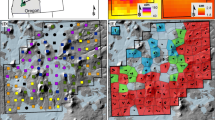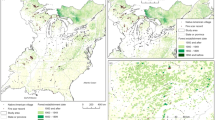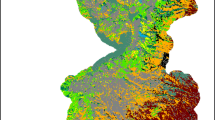Abstract
Despite the recognized importance of fire in North American boreal forests, the relative importance of stochastic and determinist portions of intra-regional spatial variability in fire frequency is still poorly understood. The first objective of this study is to identify sources of spatial variability in fire frequency in a landscape of eastern Quebec’s coniferous boreal forest. Broad-scale environmental factors considered included latitude, longitude, human activities and belonging to a given bioclimatic domain, whereas fine-scale factors included slope, position on the slope, aspect, elevation, surficial deposit and drainage. The average distance to waterbodies was also considered as a potential intermediate-scale source of variability in fire frequency. In order to assess these environmental factors’ potential influence, they were incorporated into a proportional hazard model, a semi-parametric form of survival analysis. We also used a digital elevation model in order to evaluate the dominant aspect within neighborhoods of varying sizes and successively incorporated these covariates into the proportional hazard model. We found that longitude significantly affects fire frequency, suggesting a maritime influence on fire frequency in this coastal landscape. We also found that position on the slope was related to fire frequency since hilltops and upperslopes were subject to a lower fire frequency. Dominant aspect was also related to fire frequency, but only when characterized within a neighborhood delimited by 4,000 to 10,000-m radii (5,027–31,416 ha). A 2–6-fold variation in fire frequency can be induced by geographic and topographic contexts, suggesting a substantial intra-regional heterogeneity in disturbance regime with potential consequences on forest dynamics and biodiversity patterns. Implications for forest management are also briefly discussed.




Similar content being viewed by others
References
Allison PD (1995) Survival analysis using the SAS system: a practical guide. SAS Institute Inc., Cary, North Carolina
Andison DW (2003) Tactical forest planning and landscape design. In: Burton PJ, Messier C, Smith DW, Adamowicz WL (eds) Towards sustainable management of the boreal forest. NRC Research Press, Ottawa
Angelstam PK (1997) Landscape analysis as a tool for the scientific management of biodiversity. Ecol Bull 46:140–170
Anonymous (1996) Canadian climate normals 1947–1996. Canadian Climate Program. Environment Canada, Atmospheric Environment Service. Downsview, Ontario. CD-ROM
Arno SF, Sneck KM (1977) A method for determining fire history in coniferous of the mountain west. General Technical Report INT-42. USDA Forest Service
Asselin H, Payette S, Fortin M-J, Vallée S (2003) The northern distribution of Pinus banksiana Lamb. in Canada: explaining the difference between the eastern and western distributions. J Biogeogr 30:1709–1718
Attiwill PM (1994) The disturbance of forest ecosystems: The ecological basis for conservative management. Forest Ecol Manage 63:247–300
Baker WL (1992) The landscape ecology of large disturbances in the design and management of nature reserves. Landscape Ecol 3:191–194
Beaty RM, Taylor AH (2001) Spatial and temporal variation of fire regimes in a mixed conifer forest landscape, Southern Cascades, California, USA. J Biogeogr 28:955–966
Bergeron Y, Cyr D, Drever CR et al (2006) Past, current and future fire frequency in Quebec’s commercial forests: implications for sustainable forest management.ecosystem management. Can J Forest Res 36:2737–2744
Bergeron Y, Gauthier S, Flannigan M et al (2004) Fire regimes at the transition between mixedwood and coniferous boreal forest in Northwestern Quebec. Ecology 85:1916–1932
Bergeron Y, Gauthier S, Kafka V et al (2001) Natural fire frequency for the eastern Canadian boreal forest: consequences for sustainable forestry. Can J Forest Res 31:384–391
Bergeron Y, Leduc A (1998) Relationships between change in fire frequency and mortality due to spruce budworm outbreak in the southeastern Canadian boreal forest. J Veg Sci 9:493–500
Bessie WC, Johnson EA (1995) The relative importance of fuels and weather on fire behavior in subalpine forests. Ecology 76:747–762
Bonazountas M, Kallidromitou D, Kassomenos PA et al (2005) Forest fire risk analysis. Hum Ecol Risk Assess 11:617–626
Brillinger DR, Preisler HK, Benoit JW (2003) Risk assessment: a forest fire example. In: Goldstein DR (ed) Science and statistics: a Festschrift for terry speed. Lecture Notes, Monograph Series, vol 40. Institute of Mathematical Statistics, Beachwood Ohio, pp 177–196
Broncano MJ, Retana J (2004) Topography and forest composition affecting the variability in fire severity and post-fire regeneration occurring after a large fire in the Mediterranean basin. Int J Wildland Fire 13:209–216
Clark JS (1990) Fire and climate change during the last 750 yr in Northwestern Minnesota (USA). Ecol Monogr 60:135–160
Cox DR (1972) Regression models and life-tables (with discussion). J Roy Stat Soc B 34:187–220
Cyr D, Bergeron Y, Gauthier S et al (2005) Are the old-growth forests of the clay belt part of a fire-regulated mosaic? Can J Forest Res 35:65–73
Delong SC, Kessler WB (2000) Ecological characteristics of mature forest remnants left by wildfire. Forest Ecol Manage 131:93–106
D’eon RG, Hebert D, Viszlay SL (2004) An ecological rationale for sustainable forest management concepts at Riverside Forest Products, south central British Columbia. For Chron 80:341–348
Desponts M, Payette S (1992) Recent dynamics of jack pine at its northern distribution limit in northern Quebec. Can J Bot 70:1157–1167
Dissing D, Verbyla DL (2003) Spatial patterns of lightning strikes in interior Alaska and their relations to elevation and vegetation. Can J Forest Res 33:770–782
Dorner B, Lertzman K, Fall J (2002) Landscape pattern in topographically complex landscapes: issues and techniques for analysis. Landscape Ecol 17:729–743
Engelmark O (1987) Fire history correlations to forest type and topography in northern Sweden. Ann Bot Fenn 24:317–324
ESRI, ArcView GIS 3.2a (2000) Environmental Systems Research Institute Inc. Redlands, CA
Flannigan MD (1993) Fire regime and the abundance of red pine. Int J Wildland Fire 3:241–247
Flannigan MD, Bergeron Y (1998) Possible role of disturbance in shaping the northern distribution of Pinus resinosa. J Veg Sci 9:477–482
Flannigan MD, Harrington JB (1988) A study of the relation of meteorological variables to monthly provincial area burned by wildfire in Canada (1953–80). J Appl Meteorol 27:441–452
Franklin JF (1993) Preserving biodiversity: species, ecosystems, or landscapes. Ecol Appl 3:202–205
Frelich LE, Reich PB (1995) Spatial patterns and succession in a Minnesota southern-boreal forest. Ecol Monogr 65:325–346
Gauthier S, Leduc A, Bergeron Y (1996) Forest dynamics modelling under natural fire cycles: a tool to define natural mosaic diversity for forest management. Environ Monit Assess 39:417–434
Gauthier S, Leduc A, Harvey B et al (2001) Les perturbations naturelles et la diversité écosystémique. Le Naturaliste Canadien 125:10–17
Gavin DG, Brubaker LB, Lertzman K (2003) Holocene fire history of a coastal temperate rain forest based on soil charcoal radiocarbon dates. Ecology 84:186–201
Grenier DJ, Bergeron Y, Kneeshaw D et al (2005) Fire frequency for the transitional mixedwood forest of Timiskaming, Quebec, Canada. Can J Forest Res 35:656–666
Grondin P (1996) Écologie forestière. In: Bérard JA, Côté M (eds) Manuel de foresterie. Les Presses de l’Université Laval, Québec
Heinselman ML (1973) Fire in the virgin forests of the Boundary Waters Canoe area, Minnesota. Quaternary Res 3:329–382
Hellberg E, Niklasson M, Granström A (2004) Influence of landscape structure on patterns of forest fires in boreal forest landscapes in Sweden. Can J Forest Res 34:332–338
Heyerdahl EK, Brubaker LB, Agee JK (2001) Spatial controls of historical fire regimes: a multiscale example from the Interior West, USA. Ecology 82:660–678
Hirsh K, Kafka V, Tymstra C, McAlpine R, Hawkes B, Stegehuis S, Quitilio S, Gauthier S, Peck K (2001) Fire-smart forest management: a pragmatic approach to sustainable forest management in fire-dominated ecosystems. For Chron 77:357–363
Hunter ML Jr (1990) Wildlife, forests and forestry: principles of managing forests fore biological diversity. Prentice-Hall Inc., Englewoods Cliffs, New Jersey
Hunter ML Jr, Jacobson GJJ, Webb TI (1988) Paleoecology and the coarse-filter approach to maintaining biological diversity. Conserv Biol 2:375–385
Johnson EA (1992) Fire and vegetation dynamics: studies from the North American boreal forest. Cambridge University Press, Cambridge
Johnson EA, Gutsell SL (1994) Fire frequency models, methods and interpretations. Adv Ecol Res 25:239–287
Johnson EA, Larsen CPS (1991) Climatically induced change in fire frequency in the southern Canadian Rockies. Ecology 72:194–201
Kafka V, Gauthier S, Bergeron Y (2001) Fire impacts and crowning in the boreal forest: study of a large wildfire in Western Quebec. Int J Wildland Fire 10:119–127
Kasischke ES, Williams D, Barry D (2002) Analysis of the patterns of large fires in the boreal forest region of Alaska. Int J Wildland Fire 11:131–144
Keane RE, Parsons R, Rollins MG (2004) Predicting fire regimes across multiple scales. In: Perera A (ed) Emulating natural disturbances; concepts and techniques. Cambridge University Press, Cambridge
Knowles JB (1993) The influence of forest fire induced albedo differences on the generations of mesoscale circulations. MS Thesis, Colorado State University Collins, USA
Krawchuck MA, Cumming SG, Flannigan MD et al (2006) Biotic and abiotic regulation of lightning fire initiation in the mixedwood boreal forest. Ecology 87:458–468
Kushla JD, Ripple WJ (1998) Assessing wildfire effects with landsat thematic mapper data. Int J Remote Sens 19:2493–2507
Larsen CPS (1997) Spatial and temporal variations in boreal forest fire frequency in northern Alberta. J Biogeogr 24:663–673
Lefort P, Gauthier S, Bergeron Y (2003) The influence of fire weather and land use on the fire activity of the lake Abitibi Area, eastern Canada. Forest Sci 49:509–521
Lefort P, Leduc A, Gauthier S, Bergeron Y (2004) Recent fire regime (1945–1998) in the Boreal Forest of Western Quebec. Ecoscience 11:433–445
Le Goff H, Leduc A, Bergeron Y et al (2005) The adaptative capacity of forest management to changing fire regimes in the boreal forest of Quebec. For Chron 81:582–592
Le Goff H, Sirois L (2004) Black spruce and jack pine dynamics simulated under varying fire cycles in the Northern Boreal Forest of Quebec, Canada. Can J Forest Res 34:2399–2409
Lertzman K, Fall J (1998) From forest stands to landscapes: spatial scales and the role of disturbance. In: Peterson DL, Parker VT (eds) Ecological scale: theory and applications. Columbia University Press, New York
Lertzman K, Fall J, Dorner B (1998) Three kinds of heterogeneity in fire regimes: at the crossroads of fire history and landscape ecology. Northwest Sci 72:4–23
Lesieur D, Gauthier S, Bergeron Y (2002) Fire frequency and vegetation dynamics for the south-central boreal forest of Quebec, Canada. Can J Forest Res 32:1996–2008
Masters AM (1990) Changes in forest fire frequency in Kootenay National Park, Canadian Rockies. Can J Bot 68:1763–1767
Mermoz M, Kitzberger T, Veblen TT (2005) Landscape influences on occurrence and spread of wildfires in Patagonian Forests and Shrublands. Ecology 86:2705–2715
Moritz MA, Keeley JE, Johnson EA et al (2004) Testing a basic assumption of shrubland fire management: how important is fuel age? Front Ecol Environ 2:67–72
Noss RF (1987) From plant communities to landscape in conservation inventories: a look at the nature conservancy. Biol Conserv 41:11–37
Parisien MA, Sirois L (2003) Distribution and dynamics of tree species across a fire frequency gradient in the James Bay region of Quebec. Can J Forest Res 33:243–256
Payette S (1992) Fire as a controling process in the North American boreal forest. In: Shugart HH, Leemans R, Bonan GB (eds) A system analysis of the global boreal forest. Cambridge University Press, New York
Peng CH, Apps MJ (2000) Simulating global soil-CO2 flux and its response to climate change. J Environ Sci-China 12:257–265
Reed WJ, Larsen CPS, Johnson EA et al (1998) Estimation of temporal variations in historical fire frequency from time-since-fire map data. Forest Sci 44:465–475
Robitaille A, Saucier JP (1998) Paysages régionaux du Québec méridional. Les Publications du Québec, Québec
SAS 8.02 (2001) SAS Institute Inc. Cary, NC, USA
Saucier JP (1994) Le point d'observation écologique. Ministère des Ressources naturelles, Gouvernement du Québec. Quebec City, Canada
Schimmel J, Granström A (1996) Fire severity and vegetation response in the boreal Swedish forest. Ecology 77:1436–1450
Stocks BJ, Mason JA, Todd JB et al (2002) Large forest fires in Canada, 1959–1997. J Geophys Res – Atmos 108:8149, 10.1029/2001JD000484
Schulte LA, Mladenoff DJ, Burrows SN et al (2005) Spatial controls of Pre-Euro-American wind and fire disturbance in Northern Wisconsin (USA) forest landscapes. Ecosystems 8:73–94
Seymour RS, Hunter ML Jr (1999) Principles of ecological forestry. In: Hunter ML Jr (ed) Maintaining biodiversity in forest ecosystems. Cambridge University Press, Cambridge
Thompson ID, Flannigan MD, Wotton BM et al (1998) The effects of climate change on landscape diversity: an example in Ontario Forests. Environ Monit Assess 49:213–233
Vazquez A, Moreno JM (2001) Spatial distribution of forest fires in Sierra De Gredos (Central Spain). Forest Ecol Manage 147:55–65
Weber MG, Flannigan MD (1997) Canadian boreal forest ecosystem structure and function in a changing climate: impact on fire regime. Environ Rev 5:145–166
Wein RW, MacLean DA (eds) (1983) The role of fire in northern circumpolar ecosystems. John Wiley & Sons Ltd., New York
Weisberg PJ (2004) Importance of non-stand-replacing fire for development of forest structure in the Pacific Northwest, USA. Forest Sci 50:245—258
Acknowledgements
We thank Alexandra Marier, Andréanne Aubin, Andréanne Tousignant, André-Pierre Gagnon, Ingrid Duchesneau Christine Simard and Héloïse Le Goff for assistance and advice during the preparatory stages of this study as well as two anonymous reviewers for constructive comments on an earlier draft. We are also most grateful to the Université du Québec à Montréal, the Sustainable Forest Management Network, the Ministry of Natural Resources of Quebec and Canadian Forest Service for their financial and logistical support.
Author information
Authors and Affiliations
Corresponding author
Electronic supplementary material
Rights and permissions
About this article
Cite this article
Cyr, D., Gauthier, S. & Bergeron, Y. Scale-dependent determinants of heterogeneity in fire frequency in a coniferous boreal forest of eastern Canada. Landscape Ecol 22, 1325–1339 (2007). https://doi.org/10.1007/s10980-007-9109-3
Received:
Accepted:
Published:
Issue Date:
DOI: https://doi.org/10.1007/s10980-007-9109-3




